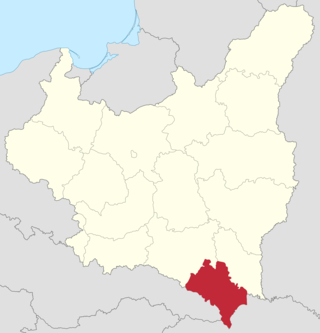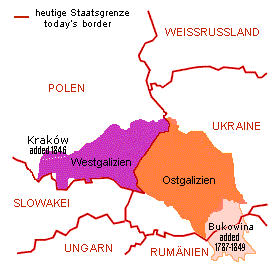
Halych is a historic city on the Dniester River in western Ukraine. The city gave its name to the Principality of Halych, the historic province of Galicia (Halychyna), and the Kingdom of Galicia–Volhynia, of which it was the capital until the early 14th century, when the seat of the local rulers moved to Lviv.

Ivano-Frankivsk Oblast, also referred to as Ivano-Frankivshchyna (Івано-Франківщина) or simply Frankivshchyna, is an oblast (region) in western Ukraine. Its administrative center is the city of Ivano-Frankivsk. It has a population of 1,351,822.

Ivano-Frankivsk, formerly Stanyslaviv, Stanislav and Stanisławów, is a city in western Ukraine. It serves as the administrative centre of Ivano-Frankivsk Oblast as well as Ivano-Frankivsk Raion within the oblast. Ivano-Frankivsk also hosts the administration of the Ivano-Frankivsk urban hromada. Its population is 238,196.

Stanisławów Voivodeship was an administrative district of the interwar Poland (1920–1939). It was established in December 1920 with an administrative center in Stanisławów. The voivodeship had an area of 16,900 km2 and comprised twelve counties (powiaty). Following World War II, at the insistence of Joseph Stalin during the Tehran Conference of 1943, Poland's borders were redrawn, Polish population forcibly resettled and Stanisławów Voivodeship was incorporated into the Ukrainian Soviet Socialist Republic as Stanislav Oblast.

Rohatyn is a city located on the Hnyla Lypa River in Ivano-Frankivsk Raion, Ivano-Frankivsk Oblast, in western Ukraine. It hosts the administration of Rohatyn urban hromada, one of the hromadas of Ukraine. Population: 7,521.

Galician Jews or Galitzianers are members of the subgroup of Ashkenazi Jews originating and developed in the Kingdom of Galicia and Lodomeria and Bukovina from contemporary western Ukraine and from south-eastern Poland. Galicia proper, which was inhabited by Ruthenians, Poles and Jews, became a royal province within Austria-Hungary after the Partitions of Poland in the late 18th century. Galician Jews primarily spoke Yiddish.

Eastern Galicia is a geographical region in Western Ukraine, having also essential historic importance in Poland.

Horodenka is a city located in Kolomyia Raion, Ivano-Frankivsk Oblast, in Western Ukraine. It hosts the administration of Horodenka urban hromada, one of the hromadas of Ukraine. Population: 8,812. In 2001 the population was around 9,800.

Sniatyn is a city located in Kolomyia Raion of Ivano-Frankivsk Oblast, in western Ukraine along the Prut river, in the historic region of Pokutia. Sniatyn hosts the administration of Sniatyn urban hromada, one of the hromadas of Ukraine. Population: 9,718. In 2001, population was around 10,500.

Vorokhta is a rural settlement located in the Carpathian Mountains on Prut River in Ukraine. It is part of Nadvirna Raion, Ivano-Frankivsk Oblast. Historically, it is a tourist spa town and later was also turned into a ski resort with several ski-jumping ramps (Avanhard). Vorokhta hosts the administration of Vorokhta settlement hromada, one of the hromadas of Ukraine. Population: 4,207 ; due to a constant flow of tourists, its population almost year-round is bigger.

Deliatyn, is a rural settlement in Nadvirna Raion, Ivano-Frankivsk Oblast, Ukraine. It is located 101 kilometers west of Chernivtsi and 294.6 miles west-southwest of Kyiv. Together with Yaremche and Lanchyn it is part of a small agglomeration that runs along the Prut River valley between the Carpathian Mountains. Deliatyn hosts the administration of Deliatyn settlement hromada, one of the hromadas of Ukraine. The population is 8,213.
Bukove is a village located in Nadvirna Raion in Ivano-Frankivsk Oblast in western Ukraine. It belongs to Pasichna rural hromada, one of the hromadas of Ukraine.

Lanchyn is a rural settlement in Nadvirna Raion, Ivano-Frankivsk Oblast, Ukraine. It hosts the administration of Lanchyn settlement hromada, one of the hromadas of Ukraine. Its population was 7,846.
Tsutsyliv is a village located in Nadvirna Raion in Ivano-Frankivsk Oblast in western Ukraine. It belongs to Pererisl rural hromada, one of the hromadas of Ukraine.

Pniv is a village located in Nadvirna Raion in Ivano-Frankivsk Oblast in western Ukraine. It belongs to Pasichna rural hromada, one of the hromadas of Ukraine.

Zelena is a village located in Nadvirna Raion in Ivano-Frankivsk Oblast in western Ukraine. It belongs to Pasichna rural hromada, one of the hromadas of Ukraine.
Hvizd is a village located in Nadvirna Raion in Ivano-Frankivsk Oblast in western Ukraine. It belongs to Nadvirna urban hromada, one of the hromadas of Ukraine.
Strymba is a village located in Nadvirna Raion in Ivano-Frankivsk Oblast in western Ukraine. It belongs to Nadvirna urban hromada, one of the hromadas of Ukraine.
Sadzhavka is a village located in Kolomyia Raion in Ivano-Frankivsk Oblast in western Ukraine. It belongs to Kolomyia urban hromada, one of the hromadas of Ukraine.

Gesher Galicia is a Jewish genealogical nonprofit organization, operating as a special interest group for those with Jewish roots from the former Austrian-ruled province of Galicia, part of modern-day western Ukraine and southeastern Poland.


























